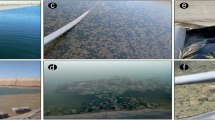Abstract
In July 2007, integrated studies of the Amur Estuary and the adjacent aquatic areas were performed on board R/V Professor Gagarinskii within the project of the Amur River basin exploration. On the basis of the data obtained during the cruise, the carbonate system of the Amur Estuary in the summer period was considered. It was shown that the distribution of the carbonate parameters in the Amur Estuary and the adjacent aquatic areas points to the high intensity of the bio-geochemical processes of production and mineralization of organic matter. It was found that the organic matter destruction is prevailing over the photosynthesis in the riverine part of the estuary. This aquatic area is a source of carbon dioxide for the atmosphere and rates as a heterotrophic basin. On the contrary, the surface waters at the outer boundaries of the estuary (the Gulf of Sakhalin and the Tatar Strait) act as a sink of the atmospheric carbon dioxide, which is caused by the intense photosynthesis in this area. This part of the estuary is treated as an autotrophic basin.
Similar content being viewed by others
References
S. V. Bruevich, “Determination of Salinity in Small Volumes of Sea Water by Direct Titration,” in Instruction to Chemical Studies of Sea Water (Glavsevmorput’, Moscow, 1944) [in Russian].
N. A. Vasilevskaya, “Study of the Structure of Humic Acids of Marine Sediments by Destructive Oxidation,” Extended Abstract of Candidate Dissertation in Chemistry (Vladivostok, 1982) [in Russian].
O. V. Dudarev, A. I. Botsul, V. V. Anikiev, et al., “Modern Sediment Accumulation in the Amur River Estuary,” Tikhookeanskaya Geologiya 19(3), 30–43 (2000).
O. V. Dudarev, “Spatiotemporal Variability in Suspension Characteristics in Estuarine Zones of Rivers in Different Climatic Situations,” in Modern Sediment Accumulation in Marginal Seas of Eastern Asia (Statistical Models) (Dal’nauka, Vladivostok, 1997), pp. 45–89 [in Russian].
I. A. Zhabin, L. N. Propp, T. I. Volkova, and P. Ya. Tishchenko, “Variability of Hydrochemical and Hydrological Parameters near the Amur River Estuary,” Okeanologiya 45(5), 703–709 (2005) [Oceanology 45 (5), 664–670 (2005)].
O. I. Koblents-Mishke, “Extraction and Non-Extraction Methods for Determination of Photosynthetic Pigments in a Sample,” in Modern Methods for Quantitative Estimation of Marine Plankton Distribution (Nauka, Moscow, 1983), pp. 114–125 [in Russian].
V. B. Kozlovskii, “Some Characteristics of the Dynamics of Waters in the Estuarine Area of the Amur River,” Tr. Gos. Okeanogr. Inst., No. 142, 93–98 (1978).
V. B. Kozlovskii, “Possible Changes in the Dynamics of Waters in the Amur River Estuary as a Result of Anthropogenic Impact,” Tr. Gos. Okeanogr. Inst., No. 159, 41–48 (1980).
L. M. Kondrat’eva, “Environmental Risk of Aquatic Ecosystem Pollution,” (Dal’nauka, Vladivostok, 2005) [in Russian].
L. M. Kondrat’eva, “Microbiological Studies of the Environmental State of the Amur River,” Vestn. DVO RAN, No. 1, 57–71 (2001).
V. G. Kryukov, B. A. Voronov, A. V. Gavrilov, and A. V. Makarov, “The Amur River: Problems and Ways to Solve Them,” (Dal’nevostochn. Aerogeodez. Predpriyatie, Khabarovsk, 2005) [in Russian].
A. P. Lisitsin, “Oceanic Marginal Filter,” Okeanologiya 34(5), 735–747 (1994).
N. I. Lobanova, “General Characteristics of the Mixing Zone in the Amur River Mouth,” Tr. DVNIGMI, No. 130, 33–44 (1987).
A. N. Makhinov, K. P. Karavanov, N. V. Boldovskii, et al., “Aquatic and Environmental Problems of the Amur River Basin,” (DVO RAN, Vladivostok, 2003) [in Russian].
G. Yu. Pavlova, P. Ya. Tishchenko, and A. P. Nedashkovskii, “Distribution of Alkalinity and Dissolved Calcium in the Sea of Okhotsk,” Okeanologiya 48(1), 101–109 (2008) [Oceanology 48 (1), 23–32 (2008)].
I. D. Rostov and I. A. Zhabin, “Hydrological Characteristics of the Amur River Mouth,” Meteorol. Gidrol., No. 7, 94–99 (1991).
P. Ya. Tishchenko, “Acid-Base Equilibrium in Sea Water,” in Studies of Marine Ecosystems and Biological Resources (Nauka, Moscow, 2007), pp. 17–186 [in Russian].
P. Ya. Tishchenko, K. Val’mann, N. A. Vasilevskaya, et al., “The Contribution of Organic Matter to the Alkaline Reserve of Natural Waters,” Okeanologiya 46(2), 211–219 (2006) [Oceanology 46 (2), 192–199 (2006)].
P. Ya. Tishchenko, P. P. Tishchenko, V. I. Zvalinskii, et al., “The Carbonate System of Amur Bay (Sea of Japan) in Summer 2005,” Izv. Tikhook. Inst. Rybn. Khoz. Okeanogr. 146, 235–255 (2006).
P. Ya. Tishchenko, G. Yu. Pavlova, A. N. Salyuk, and A. S. Bychkov, “Carbonate System and Dissolved Oxygen in the Sea of Japan: An Analysis of Biological and Thermal Factors,” Okeanologiya 38(5), 678–684 (1998) [Oceanology 38 (5), 614–619 (1998)].
L. P. Yakunin, “Substantiation of Directing the Amur River Water along a New Bed,” Tr. DVNIGMI, No. 55, 61–65 (1975).
L. P. Yakunin, “Runoff Distribution over the Fairway of the Amur River Estuary,” Tr. DVNIGMI, No. 71, 162–166 (1978).
J. H. Carpenter, “The Chesapeake Bay Institute Technique for the Winkler Dissolved Oxygen Method,” Limnol. Oceanogr. 10, 141–143 (1965).
A. G. Dickson, “pH Buffers for Sea Water Media on the Total Hydrogen Ion Concentration Scale,” Deep-Sea Res. 40, 107–118 (1993).
T. Platt, “Primary Production of the Ocean Water Column As a Function of Surface Light Intensity: Algorithms for Remote Sensing,” Deep-Sea Res. 33, 149–163 (1986).
D. K. Ralston, D. J. McGillicuddy, and D. W. Townsend, “Asynchronous Vertical Migration and Bimodal Distribution of Motile Phytoplankton,” J. Plankton Res. 29(9), 803–821 (2007).
P. Tishchenko, G. Pavlova, and A. Bychkov, “Estimation of the Biological and Thermal Effects on Partial Pressure of Carbon Dioxide and Apparent Oxygen Utilization in Seawater,” in CO2 in the Oceans (Tsukuba, 1999), pp. 259–266.
T. A. Villareal, M. A. Altabet, and K. Culver-Rymsza, “Nitrogen Transport by Vertical Migration Diatom Mats in the North Pacific Ocean,” Nature 363, 709–712 (1993).
Author information
Authors and Affiliations
Corresponding author
Additional information
Original Russian Text © A.M. Koltunov, P.Ya. Tishchenko, V.I. Zvalinskii, R.V. Chichkin, V.B. Lobanov, D.A. Nekrasov, 2009, published in Okeanologiya, 2009, Vol. 49, No. 5, pp. 694–706.
Rights and permissions
About this article
Cite this article
Koltunov, A.M., Tishchenko, P.Y., Zvalinskii, V.I. et al. The carbonate system of the amur estuary and the adjacent marine aquatic areas. Oceanology 49, 643–654 (2009). https://doi.org/10.1134/S0001437009050051
Received:
Accepted:
Published:
Issue Date:
DOI: https://doi.org/10.1134/S0001437009050051




